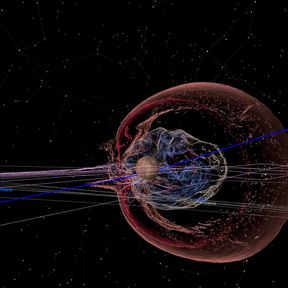On Friday night, BepiColombo will pass by Mercury for the first time

The BepiColombo, a project of the European Space Agency (ESA) and Japanese Space Agency (JAXA), was launched towards Mercury in October 2018. Its arrival into orbit around Mercury is still four years away, but before that the probe has many important intermediate stages to complete.
One of them will be reached late on Friday night, 1 October at 23:34 UTC.
‘At that point, BepiColombo will pass by Mercury for the first time,’ explains Esa Kallio, Professor of Space Physics at Aalto University. For 20 years, he has been working in the probe’s SERENA instrument group, which has built the equipment to measure particles escaping from the planet.
‘For the first time now, we will be able to experiment with using measuring instruments on Mercury,’ he says with delight.
On Friday night, BepiColombo will pass within 200 kilometres of Mercury. The task of the flyby is to reduce the probe’s speed enough that its fuel will be sufficient for the final braking process that will take it into orbit around Mercury in 2025.
The name of the probe is a tribute to the Italian mathematician Giuseppe ‘Bepi’ Colombo, born in 1920, who calculated how the gravity of planets could be used to plan probes’ flight paths.
Two probes in one package
BepiColombo is a particularly exceptional probe because it consists of two probes and a connecting carrier. When the probes are disconnected from each other at the end of 2025, the European probe will move into a closer orbit and the Japanese probe will withdraw to a more distant one.
‘The measurements made by the European Space Agency (ESA) probe will focus on investigating the planet itself and the phenomena near its surface. The Japanese probe, meanwhile, will investigate the surroundings of the planet. This allows us to get a comprehensive picture of Mercury and its space environment’ explains Esa Kallio.
The SERENA equipment measures both neutral and electrically charged particles. They come from both the Sun and the surface of Mercury as a result of solar particle fire.
‘Unlike with many Mars probes, we will not send a lander down to Mercury, but will instead collect spray from the surface and use this to determine what materials the surface of Mercury consists of’ explains Kallio.
Mercury is an earth-like rock planet whose crater-filled surface resembles the Moon. According to Kallio, one of Mercury's most special features is its internal magnetic field, which was detected during the flybys of the Mariner 10 probe in 1974 and 1975.
‘We do not yet know how such a small planet can have an internal magnetic field; nor do we understand the behaviour of the “pocket-sized magnetic bubble” formed around the planet by that magnetic field. In addition to these questions, the BepiColombo mission will seek to find out where Mercury has formed, how it has developed and whether there is water in its craters.’
The SERENA team believes that the first data on the operation of the measuring instruments will be available already on early Saturday morning. Kallio and his colleagues have spent years using space weather simulations to prepare for interpreting the measurements. You can find out more about these at the free Space Walk virtual planetarium.
As a complement to the visual content, an ad hoc modular soundtrack has been composed by doctoral student Andrea Mancianti. It is meant to characterize each celestial object sonically and offer an audio counterpart for each data visualization layer, such as the flyby trajectory. The sound is spatialized and processed by novel audio algorithms by professor Sebastian J. Schlecht and professor Vesa Välimäki.
You can download the Planetarium from https://space.aalto.fi/software/ and experience it with virtual glasses without the need for a separate computer.
Read more news

Your voice gives away valuable personal information, so how do you keep that data safe?
With speech technologies becoming increasingly common, researchers want to make sure we don’t give away more information than we mean to.
Aalto in 2025: Quantum leaps, creative breakthroughs and solutions for a better life
Growth, technology and industrial renewal; human-centred solutions; health and everyday wellbeing; and enjoyable daily life and thriving communities.
Unite! Seed Fund 2026: Call opens on 20 January 2026
Gain an early overview of the Unite! Seed Fund Call of Spring 2026. The call includes three funding lines: Student Activities, Teaching and Learning, and Research and PhD.






